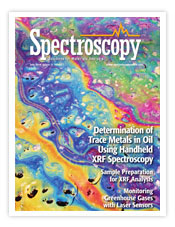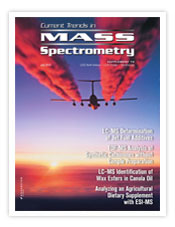In our July issue:
COLUMNS
Atomic Perspectives
X-ray Fluorescence Spectroscopy, Part II: Sample Preparation
John Anzelmo, Mathieu Bouchard, and Marie-Ève Provencher
In quantitative XRF analyses, the largest errors generally arise from sample preparation. This article provides the information you need to avoid such errors, by presenting the fundamental assumptions necessary to prepare a bulk powder material for the best possible accuracy. It also explains the physics involved during the excitation and emission processes, the major sources of error in preparing powders, and the basics of grinding and pressing, and the fusion method of sample preparation. |
ADVERTISEMENT
Superior UV-Vis Performance and Functionality
Available in standalone or PC-controlled models, Shimadzu's compact, double beam UV-1800 provides outstanding performance at an incredible price. It offers wide photometric and wavelength scanning ranges and a stable light source, while a large sample compartment accommodates both the sample and reference beam. In addition, various measurement modes are available to meet both QA/QC and R&D applications.
 Learn more Learn more |
|
Lasers and Optics Interface
Current and Emerging Laser Sensors for Greenhouse Gas Detection and Monitoring
Michael B. Frish and Mark A. Druy
In the study of global warming, obtaining good data demands widely deployed, accurate, and reliable sensors for identifying and understanding the origins, sources, and fates of greenhouse gases. Sensing technologies based on tunable diode laser absorption spectroscopy are starting to provide some of these critical data. |
Spectroscopy Spotlight
Laser-Induced Breakdown Spectroscopy: A Closer Look at the Capabilities of LIBS
Dr. Richard R. Hark, a professor in the Department of Chemistry at Juniata College in Huntingdon, Pennsylvania, discusses his work with LIBS in applications such as forensic science, conflict minerals, and geochemical fingerprinting. |
 |
PEER-REVIEWED ARTICLE
Rapid Determination of Trace Metals in Oil Using Handheld X-Ray Fluorescence Spectroscopy
Gabriel Chu, David Guinea, and Peter T. Palmer
Determination of trace metals in oil and petroleum typically is based on ICP-OES methods, requiring significant sample preparation and expensive instrumentation. This article presents an alternative method, based on the use of a handheld energy-dispersive X-ray fluorescence analyzer, that involves minimal sample preparation, uses authentic standards for calibration, gives low parts-per-million detection limits, and provides significant time and cost savings. |
ON DEMAND WEBCASTS
|
 Clinical Applications of LC-MS: Development and Research Application of a Highly Sensitive LC-MS Method for Quantification of a Cholesterol Protein in Plasma Clinical Applications of LC-MS: Development and Research Application of a Highly Sensitive LC-MS Method for Quantification of a Cholesterol Protein in Plasma |
 Part Two: Editors’ Series: Contaminant Characterization in Drinking Water: Green Methodologies Part Two: Editors’ Series: Contaminant Characterization in Drinking Water: Green Methodologies |
|
Complete Inorganic Elemental Speciation Solutions for Environmental Applications |
|
Confocal Raman Imaging for Industrial R&D Applications |
 Features of Different Mass Analysers Applied to Multi-Allergen Screening Features of Different Mass Analysers Applied to Multi-Allergen Screening |
 Part Three: Editors' Series: Analysis and Identification of Emerging Contaminants and their Transformation Products in River Water, Urban Water, and Hospital Wastewaters: Sample Preparation and LC-MS Techniques Part Three: Editors' Series: Analysis and Identification of Emerging Contaminants and their Transformation Products in River Water, Urban Water, and Hospital Wastewaters: Sample Preparation and LC-MS Techniques
|
 Interest of High Resolution ICP-OES for Rare Earth Elements Analysis in Various Applications, From Geology to Permanent Magnets Interest of High Resolution ICP-OES for Rare Earth Elements Analysis in Various Applications, From Geology to Permanent Magnets |
|
Editors’ Series: Analysis of Mercury at Parts-Per-Trillion Levels by ICP-MS Using Microwave Sample Preparation |
 Exploding Common Myths About Modular Spectroscopy Exploding Common Myths About Modular Spectroscopy |
|
 |

|
 |
Download the
issue: |
 |
 |
 |
 |
 |
| |
 |
| NEW WEBCASTS |
Learn the Tricks of the Trade to Prepare Your Lab for USP Chapters <232> and <233>
 Sign Up Now >> Sign Up Now >> |
Nanoscale IR Spectroscopy in Materials and Life Sciences
 Sign Up Now >> Sign Up Now >> |
Dual View ICP-OES—Minus the Wait
Find Out How the Agilent 5100 ICP-OES Corrects the Vision of Dual View Analysis
 Sign Up Now >> Sign Up Now >> |
|
If you would like to submit an article to Spectroscopy, contact Laura Bush, Editorial Director - [email protected]
Spectroscopy is free to qualified subscribers. To subscribe, click here.
Click here to contact the Spectroscopy sales team. |



